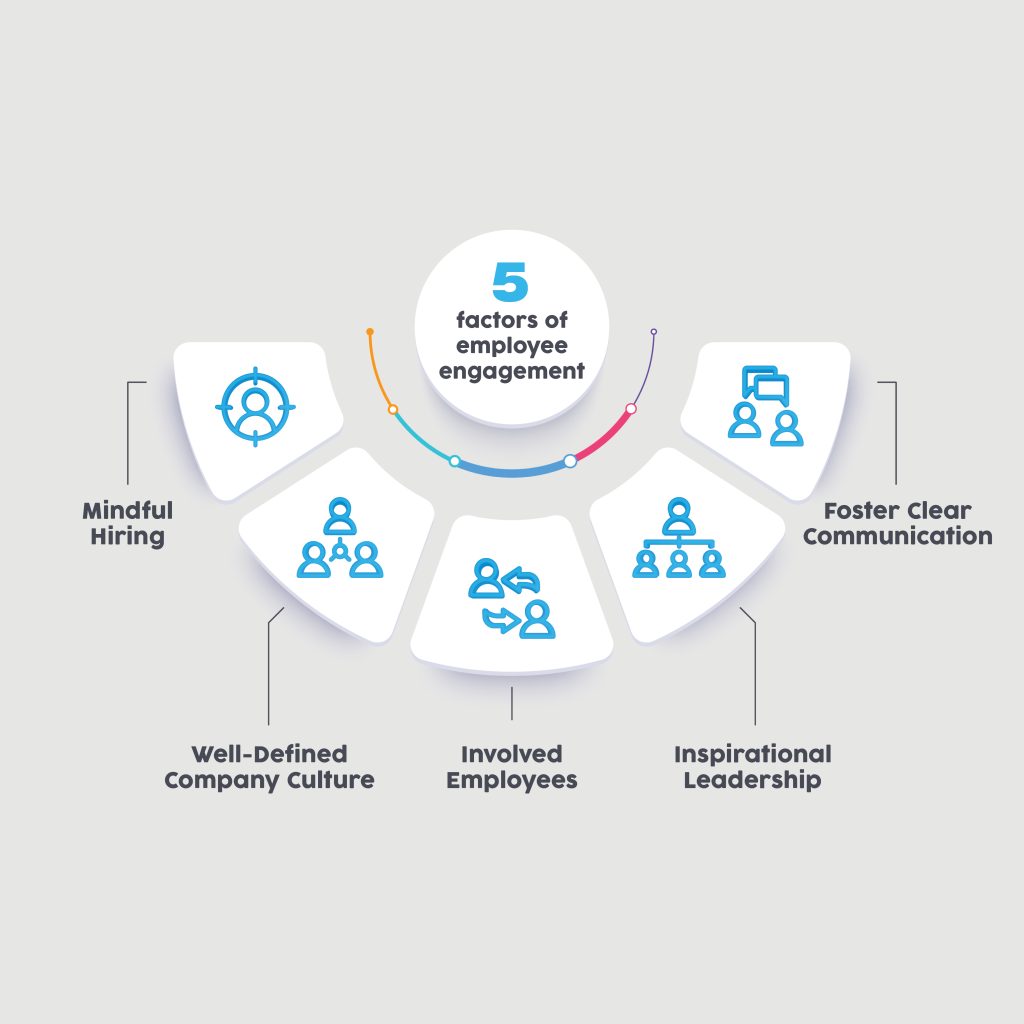Enhancing Team Performance through the Five Factors of Employee Engagement
Effective employee engagement is the key to transforming an average company into an exceptional one. However, simply hosting office pizza parties is not enough to reach the emotional core of your employees. To truly improve employee engagement, it is important to understand the most critical factors. While there are numerous articles with general recommendations for boosting employee engagement, we have sifted through research studies to present you with five essential factors, along with real-life examples. Let’s delve into what employee engagement means, why it’s crucial, and the key factors for improving it.
Table of Contents:
- The importance of employee engagement
- The top factors for employee engagement:
a. Mindful hiring practices
b. Company culture definition
c. Encouraging employee involvement
d. Cultivating inspirational leadership
e. Fostering clear communication - How to increase employee engagement using these five factors.

What does the term “employee engagement” mean?
First and foremost, let’s clarify a commonly held misconception: employee engagement should not be confused with job satisfaction. As per Forbes, although employee contentment and satisfaction are crucial factors for a productive workplace, enhancing employee engagement can surpass both of them in terms of importance.
To define employee engagement, it refers to the level of emotional commitment that an employee has towards their organization and its objectives.
While employee happiness can uplift the team’s mood and job satisfaction may reduce absenteeism, the real benefit of employee engagement lies in its potential to enhance each employee’s determination to excel in their job. This level of drive motivates team members to put in more discretionary effort, which means they will willingly go above and beyond what is required to succeed in their role without being prompted.
Looking for empirical evidence? Let’s examine some statistics.
Korn Ferry (formerly Hay Group) conducted a study using an engaged performance diagnostic survey to compare the revenue generated by their employees based on their level of engagement. The results showed that the top five most engaged offices generated an average of $72,000 more revenue per consultant than the bottom five least engaged offices.
Research by Towers Perrin indicates that companies with engaged employees achieve 6% higher net profit margins compared to their disengaged counterparts.
The Engagement Institute found that disengaged employees can result in a cost of up to $550 billion per year for companies.
As per Gallup, a highly engaged workforce can result in a 21% greater profitability.
Ultimately, employees who lack engagement may fulfill their job responsibilities, but they won’t actively contribute to driving the organization forward.
What are some strategies to identify and cultivate dedicated employees, and enhance the motivation of your existing workforce? Fortunately, there is a vast body of research available that addresses this precise issue.
a. Mindful hiring practices
Let’s begin with the first factor of employee success: mindful hiring.
To achieve this, it’s crucial to assess the entire candidate, rather than just their technical skills and background. Director of talent strategy, Gayle Norton, states that skills and knowledge aren’t enough if the candidate isn’t motivated or the right personality fit for the role. Hence, pre-employment skills assessments are gaining popularity, with roughly 82% of companies using them to select the best-fit candidates. Companies can customize these assessments to evaluate a mix of soft and hard skills required for the specific role.
While hard skills tests can ensure technical competence, soft skills tests can provide insight into a candidate’s aptitude for the role. These tests evaluate cognitive ability, situational judgment, programming skills, software skills, and language proficiency. Additionally, it’s essential to evaluate a candidate’s personality, culture fit, and values to ensure that they align with the company’s values, as employees who align with the company’s values are 13% more productive.
Ultimately, no amount of restructuring, perks, or training can compensate for an employee who isn’t the best fit for the role or the company culture.
b. Company culture definition
Εstablishing a company culture involves much more than just offering fun office perks. While employees may enjoy a ping pong table in the breakroom, it does not contribute to the company’s central mission.
After hiring candidates who are aligned with the company’s culture, it is crucial that they understand what that culture is. Otherwise, employees will be directionless, going about their daily tasks without an awareness of the organization’s greater mission or the motivation to achieve it.
According to the Ivey Business Journal, one of the ten essential elements of employee engagement is clarity. The authors explain that success in both life and organizations depends on how clear individuals are about their goals and aspirations.
So, how can companies achieve clarity for their employees?
The first step is to determine how they want employees, customers, and potential customers to perceive their brand. They should then develop a list of values that align with that vision and strive to embody them.
For instance, when General Dynamics faced a loss of almost a third of its workforce due to restructuring, it initiated a program to redefine its standards and values based on employee feedback. After conducting diagnostic surveys and targeted initiatives, GD implemented changes such as featuring employee success stories in the company newsletter. By redefining its values based on employee input and rewarding those who actively committed to the culture, GD gave its employees ownership over the company’s mission and culture, educating them on the organization’s vision.
c. Encouraging employee involvement
Alison M. Konrad, a professor at the Ivey Business School in London, Ontario, has a strong focus on what she calls high-involvement work practices, which contribute to building employee engagement. Her extensive article on the topic can be distilled down to four key principles: power, information, knowledge, and rewards.
To elaborate, giving employees power means implementing forums or suggestion systems where management takes action on employee feedback. Disseminating information involves providing employees with pertinent and specific data about their role and the overall direction of the company. Improving knowledge includes providing appropriate training and development opportunities for employees to succeed. And finally, providing rewards involves offering timely, targeted incentives to encourage employee contributions.
So how can these four principles be combined to create an engaged workplace? One example is the implementation of “modern operating agreements” at Chrysler plants. These agreements transformed the company’s internal processes by reducing job classifications, establishing consultation committees, specifying pay to skills within each classification, and reorganizing work teams. By following Konrad’s four principles, 76% of Chrysler employees preferred the new system over the old one.
It’s important to note that an employee’s direct manager is the best suited to empower and encourage them, which leads us to the fourth of the five factors of employee engagement.
d. Cultivating inspirational leadership
The saying “people leave managers, not companies” is popular for a reason: it’s true! As we mentioned earlier, the first of the 10 C’s of employee engagement is connect, meaning that leaders must show that they value employees. No matter how well a company communicates its culture and fosters employee involvement, a bad manager can hinder performance.
To cultivate inspirational leadership, it’s important to hire the right people for leadership roles and increase transparency and dialogue. For instance, General Dynamics implemented a change in performance management, shifting from a once-yearly assessment to frequent conversations covering a range of topics including career growth and wellbeing. Following this change, employees reported stronger relationships, increased motivation, and a better understanding of the company’s overall vision.
Time investment is often a key factor in inspiring leadership, as demonstrated by Clive Beddoe, CEO of WestJet Airlines. Despite being late for a speech, he took the time to connect with his team, answer questions, and explain strategy and initiatives. This exemplified strong and inspiring leadership. However, effective communication is also crucial for leaders to connect with their team.
e. Fostering clear communication
It’s time for another one of the 10 C’s, and actually, there are two: convey and congratulate. Both of these come down to the importance of clear communication.
When we talk about ‘convey,’ we mean that managers need to communicate expectations and provide feedback to employees in a way that applies to their work. And when we say ‘congratulate,’ we mean that managers need to offer specific, positive feedback as much as they offer criticism.
The Hay Group has found that “feedback is key to giving employees a sense of where they’re going, but many organizations are remarkably bad at giving it.” So, when managers get better at conveying expectations and giving feedback, they need to break down processes into manageable steps, define actionable goals, practice active listening, and pay attention to their employees’ progress.
Once managers have mastered conveying expectations and providing feedback, it’s essential that feedback goes both ways. Immediate feedback should be given for poor performance, but speedy praise should also be given for a job well done.
How does this look in action? UCLA basketball coach John Wooden was known for keeping detailed notes on each of his players and sitting down with them to offer consistent, detailed feedback. This approach showed that he paid attention to what they were doing and gave them a needed sense of direction.
It’s no surprise that 60% of employees claim they’re more productive when they understand more about what leaders are thinking, where the company is going, and what they can do to impact it. And, of course, clear communication ties into the last factor of inspirational leadership and the importance of hiring candidates who know how to communicate effectively. All of these factors work together to create a successful and engaged workplace.


